Kui Jia
Understanding Attention Mechanism in Video Diffusion Models
Apr 16, 2025Abstract:Text-to-video (T2V) synthesis models, such as OpenAI's Sora, have garnered significant attention due to their ability to generate high-quality videos from a text prompt. In diffusion-based T2V models, the attention mechanism is a critical component. However, it remains unclear what intermediate features are learned and how attention blocks in T2V models affect various aspects of video synthesis, such as image quality and temporal consistency. In this paper, we conduct an in-depth perturbation analysis of the spatial and temporal attention blocks of T2V models using an information-theoretic approach. Our results indicate that temporal and spatial attention maps affect not only the timing and layout of the videos but also the complexity of spatiotemporal elements and the aesthetic quality of the synthesized videos. Notably, high-entropy attention maps are often key elements linked to superior video quality, whereas low-entropy attention maps are associated with the video's intra-frame structure. Based on our findings, we propose two novel methods to enhance video quality and enable text-guided video editing. These methods rely entirely on lightweight manipulation of the attention matrices in T2V models. The efficacy and effectiveness of our methods are further validated through experimental evaluation across multiple datasets.
PicoPose: Progressive Pixel-to-Pixel Correspondence Learning for Novel Object Pose Estimation
Apr 03, 2025Abstract:Novel object pose estimation from RGB images presents a significant challenge for zero-shot generalization, as it involves estimating the relative 6D transformation between an RGB observation and a CAD model of an object that was not seen during training. In this paper, we introduce PicoPose, a novel framework designed to tackle this task using a three-stage pixel-to-pixel correspondence learning process. Firstly, PicoPose matches features from the RGB observation with those from rendered object templates, identifying the best-matched template and establishing coarse correspondences. Secondly, PicoPose smooths the correspondences by globally regressing a 2D affine transformation, including in-plane rotation, scale, and 2D translation, from the coarse correspondence map. Thirdly, PicoPose applies the affine transformation to the feature map of the best-matched template and learns correspondence offsets within local regions to achieve fine-grained correspondences. By progressively refining the correspondences, PicoPose significantly improves the accuracy of object poses computed via PnP/RANSAC. PicoPose achieves state-of-the-art performance on the seven core datasets of the BOP benchmark, demonstrating exceptional generalization to novel objects represented by CAD models or object reference images. Code and models are available at https://github.com/foollh/PicoPose.
Prof. Robot: Differentiable Robot Rendering Without Static and Self-Collisions
Mar 17, 2025Abstract:Differentiable rendering has gained significant attention in the field of robotics, with differentiable robot rendering emerging as an effective paradigm for learning robotic actions from image-space supervision. However, the lack of physical world perception in this approach may lead to potential collisions during action optimization. In this work, we introduce a novel improvement on previous efforts by incorporating physical awareness of collisions through the learning of a neural robotic collision classifier. This enables the optimization of actions that avoid collisions with static, non-interactable environments as well as the robot itself. To facilitate effective gradient optimization with the classifier, we identify the underlying issue and propose leveraging Eikonal regularization to ensure consistent gradients for optimization. Our solution can be seamlessly integrated into existing differentiable robot rendering frameworks, utilizing gradients for optimization and providing a foundation for future applications of differentiable rendering in robotics with improved reliability of interactions with the physical world. Both qualitative and quantitative experiments demonstrate the necessity and effectiveness of our method compared to previous solutions.
GAT-Grasp: Gesture-Driven Affordance Transfer for Task-Aware Robotic Grasping
Mar 08, 2025Abstract:Achieving precise and generalizable grasping across diverse objects and environments is essential for intelligent and collaborative robotic systems. However, existing approaches often struggle with ambiguous affordance reasoning and limited adaptability to unseen objects, leading to suboptimal grasp execution. In this work, we propose GAT-Grasp, a gesture-driven grasping framework that directly utilizes human hand gestures to guide the generation of task-specific grasp poses with appropriate positioning and orientation. Specifically, we introduce a retrieval-based affordance transfer paradigm, leveraging the implicit correlation between hand gestures and object affordances to extract grasping knowledge from large-scale human-object interaction videos. By eliminating the reliance on pre-given object priors, GAT-Grasp enables zero-shot generalization to novel objects and cluttered environments. Real-world evaluations confirm its robustness across diverse and unseen scenarios, demonstrating reliable grasp execution in complex task settings.
HWC-Loco: A Hierarchical Whole-Body Control Approach to Robust Humanoid Locomotion
Mar 02, 2025Abstract:Humanoid robots, capable of assuming human roles in various workplaces, have become essential to the advancement of embodied intelligence. However, as robots with complex physical structures, learning a control model that can operate robustly across diverse environments remains inherently challenging, particularly under the discrepancies between training and deployment environments. In this study, we propose HWC-Loco, a robust whole-body control algorithm tailored for humanoid locomotion tasks. By reformulating policy learning as a robust optimization problem, HWC-Loco explicitly learns to recover from safety-critical scenarios. While prioritizing safety guarantees, overly conservative behavior can compromise the robot's ability to complete the given tasks. To tackle this challenge, HWC-Loco leverages a hierarchical policy for robust control. This policy can dynamically resolve the trade-off between goal-tracking and safety recovery, guided by human behavior norms and dynamic constraints. To evaluate the performance of HWC-Loco, we conduct extensive comparisons against state-of-the-art humanoid control models, demonstrating HWC-Loco's superior performance across diverse terrains, robot structures, and locomotion tasks under both simulated and real-world environments.
You Only Teach Once: Learn One-Shot Bimanual Robotic Manipulation from Video Demonstrations
Jan 24, 2025Abstract:Bimanual robotic manipulation is a long-standing challenge of embodied intelligence due to its characteristics of dual-arm spatial-temporal coordination and high-dimensional action spaces. Previous studies rely on pre-defined action taxonomies or direct teleoperation to alleviate or circumvent these issues, often making them lack simplicity, versatility and scalability. Differently, we believe that the most effective and efficient way for teaching bimanual manipulation is learning from human demonstrated videos, where rich features such as spatial-temporal positions, dynamic postures, interaction states and dexterous transitions are available almost for free. In this work, we propose the YOTO (You Only Teach Once), which can extract and then inject patterns of bimanual actions from as few as a single binocular observation of hand movements, and teach dual robot arms various complex tasks. Furthermore, based on keyframes-based motion trajectories, we devise a subtle solution for rapidly generating training demonstrations with diverse variations of manipulated objects and their locations. These data can then be used to learn a customized bimanual diffusion policy (BiDP) across diverse scenes. In experiments, YOTO achieves impressive performance in mimicking 5 intricate long-horizon bimanual tasks, possesses strong generalization under different visual and spatial conditions, and outperforms existing visuomotor imitation learning methods in accuracy and efficiency. Our project link is https://hnuzhy.github.io/projects/YOTO.
Efficient and Context-Aware Label Propagation for Zero-/Few-Shot Training-Free Adaptation of Vision-Language Model
Dec 24, 2024Abstract:Vision-language models (VLMs) have revolutionized machine learning by leveraging large pre-trained models to tackle various downstream tasks. Despite improvements in label, training, and data efficiency, many state-of-the-art VLMs still require task-specific hyperparameter tuning and fail to fully exploit test samples. To overcome these challenges, we propose a graph-based approach for label-efficient adaptation and inference. Our method dynamically constructs a graph over text prompts, few-shot examples, and test samples, using label propagation for inference without task-specific tuning. Unlike existing zero-shot label propagation techniques, our approach requires no additional unlabeled support set and effectively leverages the test sample manifold through dynamic graph expansion. We further introduce a context-aware feature re-weighting mechanism to improve task adaptation accuracy. Additionally, our method supports efficient graph expansion, enabling real-time inductive inference. Extensive evaluations on downstream tasks, such as fine-grained categorization and out-of-distribution generalization, demonstrate the effectiveness of our approach.
GUS-IR: Gaussian Splatting with Unified Shading for Inverse Rendering
Nov 12, 2024


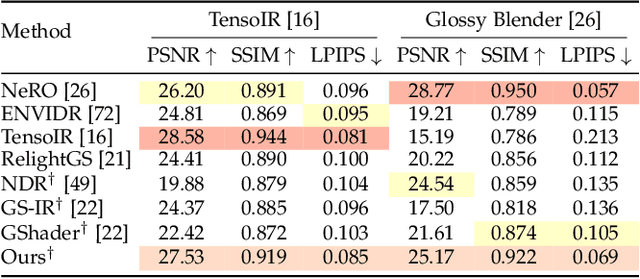
Abstract:Recovering the intrinsic physical attributes of a scene from images, generally termed as the inverse rendering problem, has been a central and challenging task in computer vision and computer graphics. In this paper, we present GUS-IR, a novel framework designed to address the inverse rendering problem for complicated scenes featuring rough and glossy surfaces. This paper starts by analyzing and comparing two prominent shading techniques popularly used for inverse rendering, forward shading and deferred shading, effectiveness in handling complex materials. More importantly, we propose a unified shading solution that combines the advantages of both techniques for better decomposition. In addition, we analyze the normal modeling in 3D Gaussian Splatting (3DGS) and utilize the shortest axis as normal for each particle in GUS-IR, along with a depth-related regularization, resulting in improved geometric representation and better shape reconstruction. Furthermore, we enhance the probe-based baking scheme proposed by GS-IR to achieve more accurate ambient occlusion modeling to better handle indirect illumination. Extensive experiments have demonstrated the superior performance of GUS-IR in achieving precise intrinsic decomposition and geometric representation, supporting many downstream tasks (such as relighting, retouching) in computer vision, graphics, and extended reality.
On the Adversarial Risk of Test Time Adaptation: An Investigation into Realistic Test-Time Data Poisoning
Oct 07, 2024Abstract:Test-time adaptation (TTA) updates the model weights during the inference stage using testing data to enhance generalization. However, this practice exposes TTA to adversarial risks. Existing studies have shown that when TTA is updated with crafted adversarial test samples, also known as test-time poisoned data, the performance on benign samples can deteriorate. Nonetheless, the perceived adversarial risk may be overstated if the poisoned data is generated under overly strong assumptions. In this work, we first review realistic assumptions for test-time data poisoning, including white-box versus grey-box attacks, access to benign data, attack budget, and more. We then propose an effective and realistic attack method that better produces poisoned samples without access to benign samples, and derive an effective in-distribution attack objective. We also design two TTA-aware attack objectives. Our benchmarks of existing attack methods reveal that the TTA methods are more robust than previously believed. In addition, we analyze effective defense strategies to help develop adversarially robust TTA methods.
Boosting Cross-Domain Point Classification via Distilling Relational Priors from 2D Transformers
Jul 26, 2024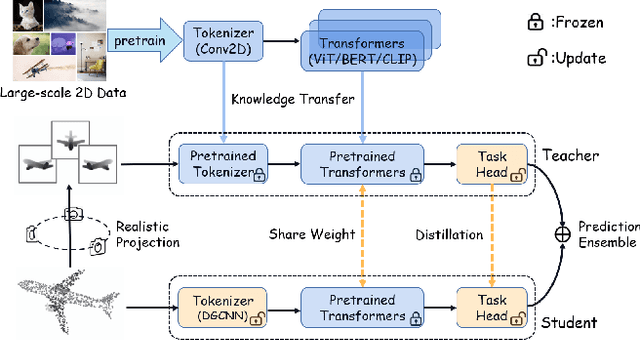
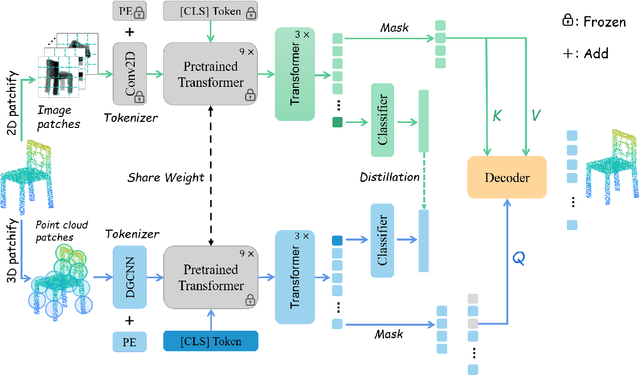
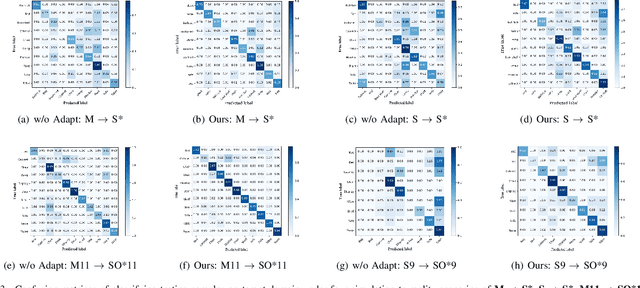
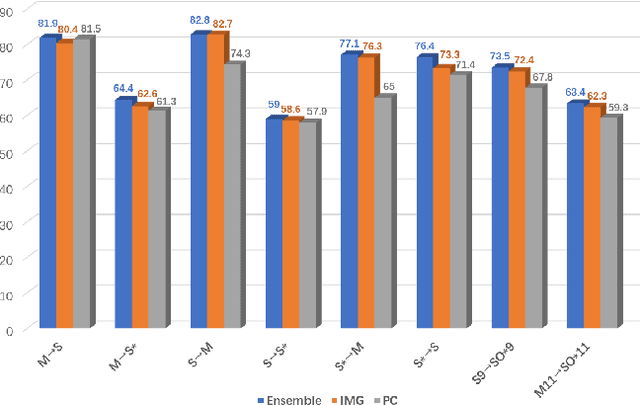
Abstract:Semantic pattern of an object point cloud is determined by its topological configuration of local geometries. Learning discriminative representations can be challenging due to large shape variations of point sets in local regions and incomplete surface in a global perspective, which can be made even more severe in the context of unsupervised domain adaptation (UDA). In specific, traditional 3D networks mainly focus on local geometric details and ignore the topological structure between local geometries, which greatly limits their cross-domain generalization. Recently, the transformer-based models have achieved impressive performance gain in a range of image-based tasks, benefiting from its strong generalization capability and scalability stemming from capturing long range correlation across local patches. Inspired by such successes of visual transformers, we propose a novel Relational Priors Distillation (RPD) method to extract relational priors from the well-trained transformers on massive images, which can significantly empower cross-domain representations with consistent topological priors of objects. To this end, we establish a parameter-frozen pre-trained transformer module shared between 2D teacher and 3D student models, complemented by an online knowledge distillation strategy for semantically regularizing the 3D student model. Furthermore, we introduce a novel self-supervised task centered on reconstructing masked point cloud patches using corresponding masked multi-view image features, thereby empowering the model with incorporating 3D geometric information. Experiments on the PointDA-10 and the Sim-to-Real datasets verify that the proposed method consistently achieves the state-of-the-art performance of UDA for point cloud classification. The source code of this work is available at https://github.com/zou-longkun/RPD.git.
 Add to Chrome
Add to Chrome Add to Firefox
Add to Firefox Add to Edge
Add to Edge